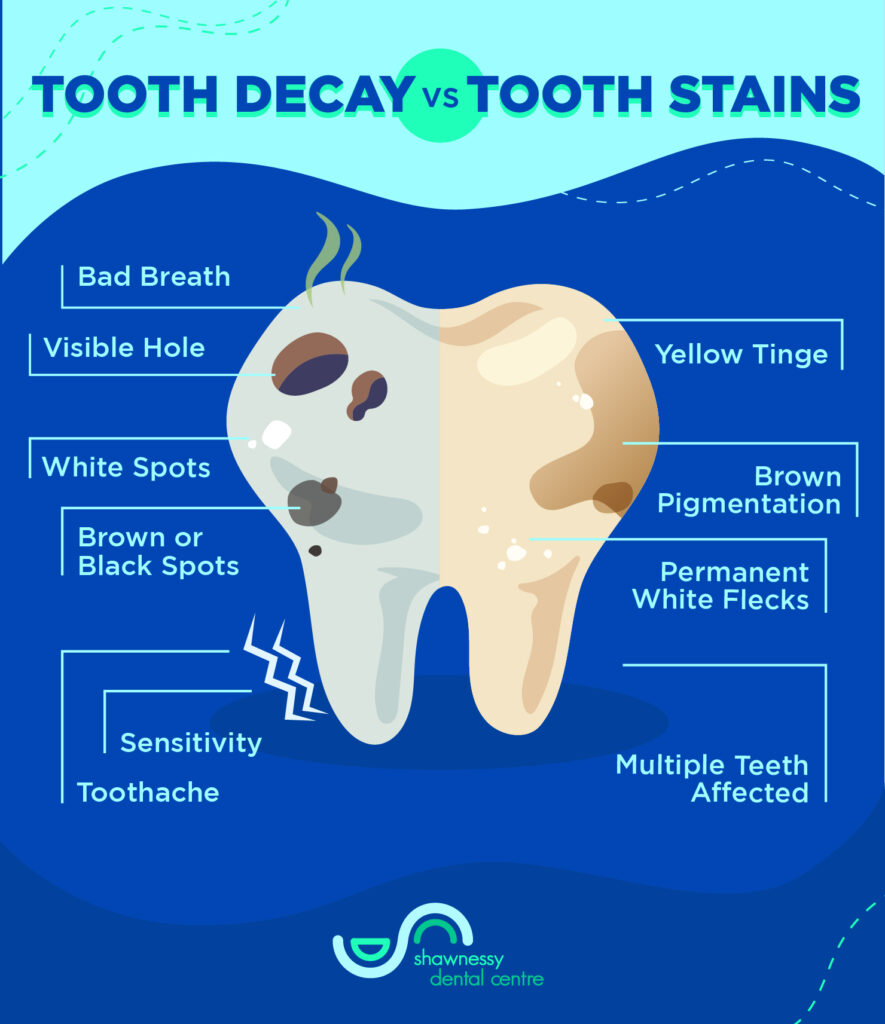Chances are, you will encounter tooth stains or cavities in your lifetime. Teeth can become stained from lifestyle habits like consuming dark-coloured foods and drinks over time. Surface stains often appear yellowish and can easily be corrected with whitening, but if they’re accompanied by persistent pain, sensitivity, or visible holes, you’re likely dealing with a cavity.
If you notice signs of a cavity, it’s crucial to visit your dentist for a checkup. They can identify decay and provide a suitable treatment. Keeping up with regular dental cleanings and checkups also means your dentist can spot potential problems early and save you the trouble of more invasive treatments.
What Is a Cavity?
A cavity is a hole that forms in the surface of your tooth. It’s caused by tooth decay, which occurs when the bacteria in your mouth feed on the sugars and starches from the food you eat. These bacteria produce acids that attack your tooth enamel, eventually causing cavities.
How Do Cavities Form?
Cavities can form due to a variety of factors. Not brushing and flossing regularly can allow bacteria to thrive and contribute to tooth decay. Consuming sugary and acidic foods and drinks can accelerate the process of cavity formation. Even if you have good oral hygiene, certain genetic factors and medical conditions can make you more susceptible to cavities.
Symptoms of Tooth Decay
Your dentist can pick up on early signs of tooth decay during a routine checkup, but if you haven’t been in to see your dentist recently, here are some telltale signs to watch for:
- Tooth sensitivity: Sensitivity, especially to hot, cold, or sweet foods, can be an early indicator of tooth decay. If you find yourself wincing at everyday treats, it’s time to pay attention.
- Tooth pain: If you have continuous discomfort or pain in a specific tooth, it’s worth scheduling an appointment to investigate further.
- Visible discolouration: Take a peek in the mirror—are there any noticeable brown, black, or white spots on your teeth? Discolouration can be a sign of tooth decay.
- Bad breath: We all have moments of morning breath, but persistent bad breath could be a red flag. The bacteria causing tooth decay release foul-smelling gases. So, if you’re faced with chronic halitosis, it’s time to consider the possibility of tooth decay.
- Holes or pitting: Have you noticed small pits or visible holes forming on the surface of your teeth? A hole in your tooth is a cavity and a clear indication that tooth decay is underway. Don’t wait for them to grow larger—they’re easier to treat when small.
What Is a Tooth Stain?
Tooth stains occur when the outer layer of your teeth, known as the enamel, becomes discoloured or stained. There are 2 primary types of tooth stains:
- Extrinsic stains: These are superficial stains on the outer layer of the tooth. Common culprits include pigmented foods and beverages like coffee, tea, red wine, and berries. Tobacco use, poor oral hygiene, and certain medications can also contribute to extrinsic stains.
- Intrinsic stains: Intrinsic stains are deeper and originate within the tooth structure itself. They can be caused by aging, genetics, excessive fluoride exposure during tooth development, trauma to the tooth, or certain medications. Intrinsic stains may require professional intervention for effective treatment.

Common Causes of Tooth Stains
It’s no surprise that our favourite beverages can be a common cause of tooth stains, but tobacco use, oral hygiene, and aging can also contribute.
Some of the most common culprits of tooth stains include:
- Beverages: Dark-coloured drinks like coffee, tea, and red wine contain pigments called chromogens that can latch onto the enamel, leading to discolouration over time.
- Tobacco: Tobacco products, whether smoked or chewed, are notorious for causing tooth stains. The tar and nicotine in tobacco can penetrate tooth enamel, resulting in stubborn yellow or brown stains.
- Poor oral hygiene: Neglecting your oral hygiene routine can pave the way for tooth stains. Inadequate brushing and flossing allow plaque and tartar to build up, creating the perfect environment for stains to develop.
- Aging: As we age, our tooth enamel naturally wears down, revealing the underlying layer called dentin, which has a yellowish tinge.
- Certain foods: Some foods are more prone to causing tooth stains than others. Berries, tomato-based sauces, curry, and balsamic vinegar contain pigments that can stick to tooth enamel. Additionally, acidic foods like citrus fruits and sodas can erode the enamel, making it easier for stains to take hold.
Can Tooth Stains Turn into Cavities?
Contrary to popular belief, tooth stains themselves do not directly turn into cavities. However, stains can indirectly contribute to the development of cavities. Certain stain-causing substances, like sugary beverages or acidic foods, can fuel bacterial growth and acid production, increasing the risk of cavities.
Treatments for Cavities & Tooth Stains
The treatment for your tooth concern depends on whether it’s a simple stain or a true cavity. If you’re dealing with staining, there are some easy ways to remove them:
- Brushing and flossing daily
- Using whitening toothpaste
- Using at-home whitening strips
- Undergoing professional whitening
Treating tooth decay requires care from your dentist. The level of treatment you need depends on how deep the decay has reached. Cavity treatments include:
- Fillings
- Crowns or partial crowns
- Bonding
- Root canal therapy
Prevent & Treat Tooth Decay
While stains and cavities can initially look alike, some key factors can help you tell the difference:
- If an entire tooth or multiple teeth appear discoloured, chances are it’s a stain and not a cavity.
- Increased tooth sensitivity or pain may indicate you’re dealing with a cavity rather than a simple stain.
If you experience persistent tooth pain or see a visible hole in your tooth, visit us at Shawnessy Dental for a thorough examination. We can treat tooth decay, help with cavity prevention, and offer professional whitening.


